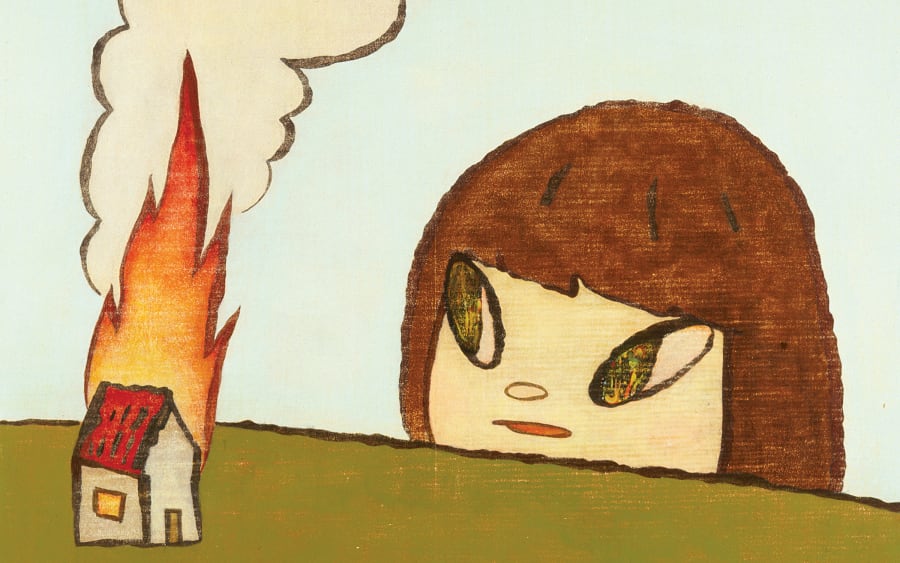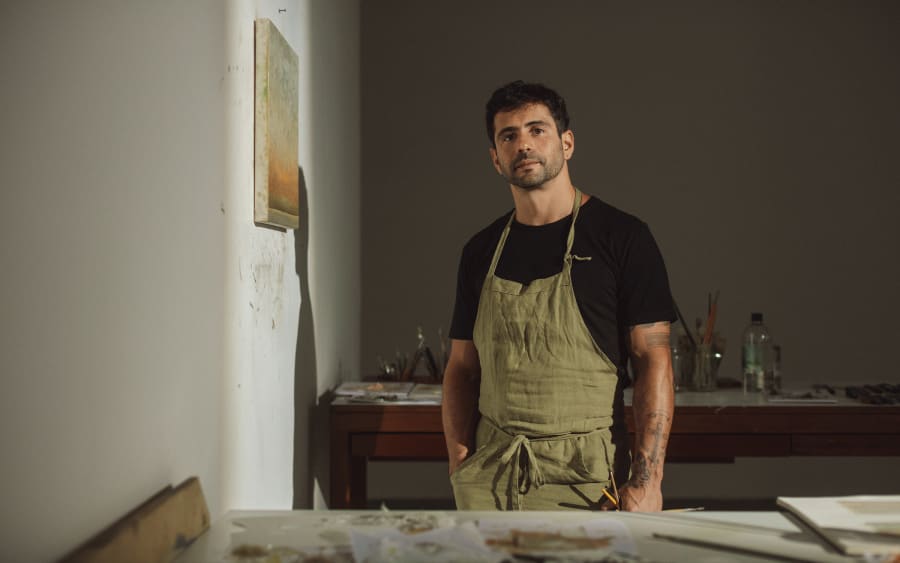It’s interesting that two major institutions – Ghent’s S.M.A.K. in Europe and MCA Chicago in the US – recently planned exhibitions that took the supposed death of painting as a starting premise. ‘Painting after Painting’, which opened on April 4 at S.M.A.K., offers a homed-in look at painters in Belgium, while ‘The Living End: Painting and Other Technologies, 1970–2020’, which recently closed at the MCA, surveyed the impact of emerging technologies on the medium over the past 50 years. But despite the perennial proclamations of painting’s demise, young artists continue to embrace and push the medium’s traditions, and as collectors increasingly embrace emerging artists, it’s likely that painting will forever bloom.
Take, for example, the British artist Francesca Mollett (b. 1991, UK). Currently showing nine paintings at The Warehouse in Dallas, Texas, Mollett produces abstractions that focus on the brushstroke itself. Akin to visual streams of consciousness, pulsing with layered rhythms of light and color, her works have exceeded market expectations, even though she only graduated from the Royal College of Art, London, in 2020. Two Thistles (2021), her play on the Van Gogh painting of the same name, was given a high estimate of GBP 35,000 but fetched more than GBP 250,000 in a 2023 auction with Phillips. With her pieces included in ‘Present Tense’, a show of up-and-coming UK talent held last year at Hauser & Wirth Somerset, and recently acquired by ICA Miami and K11 Art Foundation in Hong Kong, Mollett is becoming a presence that is sure to tower.
Not having any kind of digital presence might sound like bad business in the art world, but Samuel Hindolo (b. 1990, US) proves that mysteriousness can still be a crucial strategy for artists. His figurative paintings mix cinematic realism with a sort of abstract mistiness. Yet, steering clear of a defining style, Hindolo also paints abstract grids. One throughline is that they all feel expertly drained of some essential quality: Figures bereft of identifiers, among eerie settings, are like collaged hints that keep viewers guessing. Hindolo’s 2020 exhibition at 15 Orient in New York got the attention of the critic Hilton Als, and in a rare maneuver for The New Yorker, Als wrote about him again last year. Besides his inclusion in ‘Painting after Painting’ at S.M.A.K., the enigmatic artist also recently organized a group show at Galerie Buchholz, New York, open through May 10.
Meanwhile, provocation is the name of the game for Stanislava Kovalčíková (b. 1988, Slovakia). In 2024 at Aspen Art Museum she exhibited two paintings, one of them a reclining figure whose face is a void, lit only by the glow of a video piece by the Austrian enfant terrible VALIE EXPORT. Kovalčíková’s figurative works ooze a dark, horny, mythological humor; she has said that the works function like ‘magic spells.’ Opened in February 2023, her independent exhibition space The White Ermine has electrified the Düsseldorf scene with its ramshackle spirit. On the heels of her first show with Emalin last spring, Kovalčíková will also be in a group show at the London gallery at the end of this year and on view at the gallery’s booth at Art Basel in Basel.
When done right, seemingly banal images can also induce dreamlike states. Evelyn Plaschg (b. 1988, Austria) uses phone photos as starting points for her unsettling paintings. Though her subjects used to be people, she has turned her eye to objects such as zippers, pockets, and seats, and the results are striking meditations on the possibilities of the fragment. Since receiving her MFA from the Academy of Fine Arts Vienna in 2021, Plaschg has shifted to more elliptical spaces: By focusing intensely on everyday objects, she reveals their inherent formal extravagance. In ‘Viscous City’, her first solo museum exhibition in Austria, opening June 27 at HALLE FÜR KUNST Steiermark, the artist will unveil a new body of work that documents her turn to urban spaces and their architectures.
A far more gestural approach is taken by Libasse Ka (b. 1998, Senegal). Besides his inclusion in ‘Painting after Painting’, Ka will also have his first solo museum show this year at Museum Dhondt-Dhaenens in Belgium, quite a feat for an artist in his mid-twenties. Sparsely arranged geometric shapes float across his canvases – he cites Mondrian as an influence – as do smeared gestures and a recurring, shadowy figure. Ka has been making waves with his atmospheric work: He intentionally avoids explicit narratives to thrilling effect, playing with the audience’s expectations. Last year, the Carlos/Ishikawa booth at Art Basel Paris was dedicated to Ka; it sold out completely.
In her recent exhibition at Magenta Plains in New York, titled ‘our arrangement our arrangement our arrangement’, Liza Lacroix (b. 1988, Canada) burrowed into bleak color fields. In the painter’s expert hands, dense black gloom is a sublime experience, but then so are her scanty graphite smudges on white expanses. As the world increasingly resembles the 19th century, it makes sense that Lacroix’s romanticism, what might be called an abstract confessionalism, has struck a nerve. Held in the collections of Oslo’s Astrup Fearnley Museet, ICA Miami, and the Aïshti Foundation in Lebanon, the artist will have a major presentation in this year’s Unlimited sector at Art Basel in Basel, followed by a solo exhibition at Galerie Chantal Crousel in Paris later this year.
While Lacroix plumbs the psyche, Reina Sugihara (b. 1988, Japan) makes abstract paintings that reveal more physical interiorities. Her earth-toned canvases look like cross-sections of biological or geological structures. Each of them is labored over for months or even years. Over the past year, the artist has had two solo gallery shows (at London’s Arcadia Missa and Hong Kong’s Empty Gallery), and she is working on her next one at Croy Nielsen in Vienna. At Empty Gallery, whose conceit is showing art in the dark, Sugihara presented paintings as if they were each an organ. Using pointillist vortexes and other organic shapes, the Japanese painter toys with accumulation, subtraction, and neglect to evoke the very inside of ourselves.
Of all the artists here, Roméo Mivekannin (b. 1986, Ivory Coast) is the one most invested in the iconography of classical figurative painting, but a recurring, sly motif turns examples of this on their heads. Mivekannin, who is showing at Unlimited this year, inserts himself into iconic works, playing on Caravaggio’s The Lute Player and Géricault’s The Raft of the Medusa, reminding viewers of the role African figures played on the continent. This is not merely a conceptual concern for the artist: Mivekannin’s ancestor was the king of what is now Benin, who had his treasures looted by French colonists. To create his paintings, Mivekannin also uses materials like bedsheets and voodoo elixirs; his dark yet seductive works are included in the collections of Sharjah Art Foundation and Musée du quai Branly in Paris, and currently on view at the Louvre Lens in Northern France and the prestigious Collezione Maramotti in Italy.
A far more minimalist approach to painting is taken by Blerta Hashani (b. 1997, Kosovo), who creates serene renditions of the Kosovar countryside. Hashani, who showed at Manifesta 14 in 2022, is represented by Pristina’s LambdaLambdaLambda, a pivotal gallery for getting contemporary Balkan artists international circulation. The painter was included in several important group shows recently, including ‘Silent Threads, Resounding Kosova’ at Galleria Continua in Paris, and ‘Perceive, Record, Imagine’ at Galeria 17 in Kosovo. Her idylls contain blood-orange suns, snails, puffs of forest, and snatches of handwriting, rendered sparsely and elegantly. The paintings are small – one is on an old wooden spatula measuring 20 cm – but there is power in such portability. Each painting is a soothing respite from a big noisy world.
There’s a darker pastoralism at play in the work of Oliver Bak (b. 1992, Denmark), represented by Sprüth Magers. With an almost Victorian aesthetic and a predilection for Art Nouveau, Bak’s canvases contain ghostly figures in landscapes that appear caught between bloom and decay. A splotchy mysticism haunts these paintings, so it makes sense that Bak is included in ‘Evil Flowers’, an exhibition at Berlin’s Sammlung Scharf-Gerstenberg, based on Baudelaire’s norm-shattering volume of poems. Flowers recurred again and again in Bak’s recent Sprüth Magers show – ‘Ghost Driver, or The Crowned Anarchist’ – and yet, they are deeply unsettling, proving that painting creates an atmosphere like no other medium. One of Bak’s works, ‘Pale Shadow’ (2021), sold at a Phillips auction last month for more than twice its high estimate – another market indication that painting is indeed never dead.
Francesca Moffett is represented by Grimm Gallery (Amsterdam, London, New York) , Modern Art (London, Paris), and Micki Meng (San Francisco).
Samuel Hindolo is represented by Galerie Buchholz (Cologne, Berlin, New York).
Stanislava Kovalčíková is represented by Antenna Space (Shanghai) and Emalin (London).
Evelyn Plaschg is represented by Layr (Vienna).
Libasse Ka is represented by Carlos/Ishikawa (London).
Liza Lacroix is represented by Galerie Chantal Crousel (Paris), Galerie Gisela Capitain (Cologne, Berlin, Naples) and Magenta Plains (New York).
Reina Sugihara is represented by Empty Gallery (Hong Kong) and Arcadia Missa (London).
Roméo Mivekannin is represented by Galerie Cécile Fakhoury (Abidjan, Dakar, Paris), Galerie Barbara Thumm (Berlin), and Galerie Eric Dupont (Paris).
Blerta Hashani is represented by LambdaLambdaLambda (Pristina).
Oliver Bak is represented by Sprüth Magers (Berlin, London, Los Angeles, New York) and Adz (Lisbon).
Rob Goyanes is a writer and editor from Miami, Florida. His work has appeared in BOMB, e-flux journal, Los Angeles Times, and elsewhere. He lives in Los Angeles, California.


